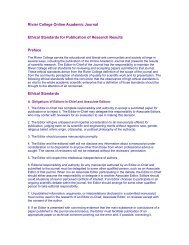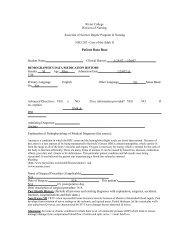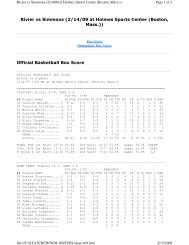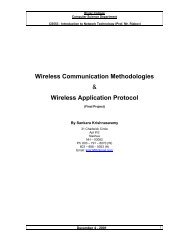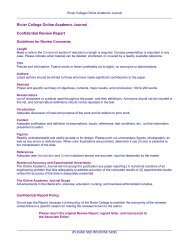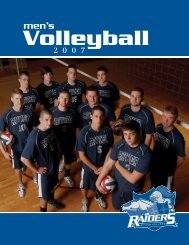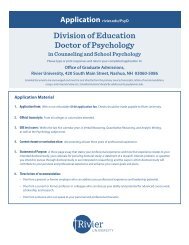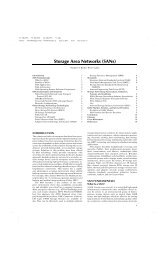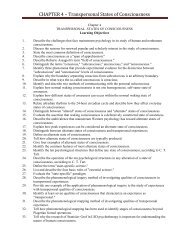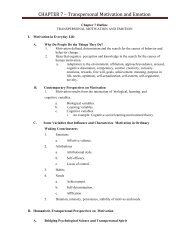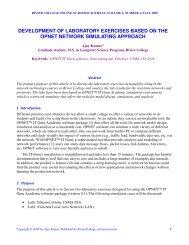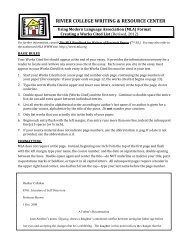99-3207 - AIAA
99-3207 - AIAA
99-3207 - AIAA
Create successful ePaper yourself
Turn your PDF publications into a flip-book with our unique Google optimized e-Paper software.
(c)l<strong>99</strong>9 American Institute of Aeronautics & Astronautics<br />
A<strong>99</strong>933421<br />
AMA-<strong>99</strong>-<strong>3207</strong><br />
SHOCK INTERF’ERENCE IN HYPERSONIC RAREFIED-GAS FLOWS<br />
NEARACYLINDER<br />
Vladimir v. Riabov’<br />
University of New Hampshire<br />
Mznchester. New Hampshire 03101, USA<br />
. and<br />
Andrei V. Botin+<br />
Central Aem-Hydrodynamics Institute (TSAGI)<br />
Du~kovsky-3, Moscow Region 140160, Russia<br />
Abstract<br />
;r :<br />
The interference of an impinging plane oblique<br />
shock wave with the viscous shock laya on a<br />
cylinder modeling a hypemonic inlet edge has been<br />
studied experimentally and numerically for rarefiedgas<br />
flow regimes at the Reynolds numbers 15.5 S<br />
Reo S 124 and Knudsen numba~ 0.12 Kn 2 0.012.<br />
The numcsical calculations have been paformed<br />
withii the hmewcrk of the Jhct Siiulation<br />
MonteCarlo technique and t& Navier~tokes<br />
equationsfwapaf&tgasusingtbeshockcaptming<br />
me&xi. The principal proper& of the fiowpammews<br />
distribution have been studied for five<br />
diffwaa types of interfaaha at low Reynolds<br />
numba-s.Thedi&renaawith~tothe<br />
previously investigated intafama regimes for high<br />
Reynolds numbas were examined as well. The<br />
comparison analysis ofnumericai results and<br />
experimentalda.tahasbeenprovided.Ithasbeen<br />
found that the local pressure and heat transfw<br />
coefficients on the surfaa of a cylinder may<br />
considerably(bya&torof35)exceedthevaJueson<br />
the edge stagnation line ohsaved in the absence of<br />
interference The type IV of the intafaena patterns<br />
in continuum media has not heen found in the study.<br />
Nomenclature<br />
c, = bcal skin-friction coefficient, rJq-<br />
=P = pressure coefficient, Qw - ps/4-<br />
H = total entbalpy<br />
hi = Mach number<br />
=Lecm~cdkgcofEngia&ringaadPhysical~400<br />
ctmmaidstrr&Maldlaw<br />
‘ResearcbSdenticf-GasDylrsmicrBrrncb<br />
. DivisiaL<br />
VIbc-Inslilulcof-ticsand<br />
Astrauutia. All lights fmavcd.<br />
~R=Knudsennumber .<br />
P =prcssm N&l2<br />
4 =heatflux<br />
= dynamic pressure, 0.5~~~<br />
t = radius of a cylinder. 0.01 m<br />
Reo F Reynolds numher, paJUp(To)<br />
St = Stanton numba? q&w4To - TI> .<br />
T =-K,<br />
c =tanpaaturefacta;TsTo<br />
x,y =qutedan-<br />
B ~~gleofinclinationoftheshock .,<br />
Y = qecif~c heatration. 1.4<br />
tl =secondcurvilinearco&dit&te<br />
Q, ===“‘=‘gkdeg,<br />
c1 =viscositycoef6ci~t .<br />
0 =apexangleofawedg~deg<br />
P =&&y,k& .<br />
=mbJjm2rk ;<br />
; .=Grstauvilincarcoa7linate . .*<br />
SubSCriDts :, I.<br />
R = cylinder radius ,as a length-scale pammemr<br />
=~coa&ti()g’ , _. t<br />
0” =sagnatioll~. *. ’<br />
- =lkeestfeamparameter<br />
IlltdUCtiOXl<br />
The optimum flow rate through the air intake of a<br />
hypersonic vehicle would be obtained under a condition<br />
that the oblique shock wave from its fixward section<br />
impinges on the blunt edge of the air intake”. At<br />
hypersooic amtinuum flow regimes, six types of<br />
intcrferena between an impinging oblique shock and a<br />
viscous shock layer near a cylindricaJ blunt edge had<br />
been studied by Edne$, Wieting and Holden’, Borovo?,<br />
Borovoi et al!. Purpura et aI?, and Tannebill, J. C..<br />
Hoist, T. L, and Rakich, J? The studies indicate that<br />
pressure and heat flux on the surface of the body may<br />
,<br />
746
(c)l<strong>99</strong>9 American Institute of Aeronautics & Astronautics<br />
considerably exceed the values on the edge<br />
stagnation line in the absence of interference. The<br />
rarefied-gas hypersonic flow regimes had been<br />
analyzed in experiments of Botin9 and Pot et al.”<br />
In the present study, the interference of an<br />
impinging shock with the viscous shock layer on a<br />
cylinder modeling a hypersonic inlet edge has been<br />
studied experimentally and numerically for rarefiedgas<br />
flow regimes at the Reynolds numbers 15.55<br />
Reo I 124 and Knudsen numbers 0.12 KnR 2 0.012.<br />
The numerical results have been obtained using the<br />
direct simulation Monte Carlo (DSMC) technique”<br />
and the shock capturing method” applied to the<br />
system of the Navier-Stokes equations. The DSMC<br />
computer codeI was developed by G. Bird. Results<br />
are compared with experimental dataobtained in the<br />
vacuum wind tunnel.<br />
Flow Patterns<br />
We consider the interference of steady flow<br />
around an infinite circular cylinder and an<br />
impinging oblique shock in hypersonic stream of<br />
rarefied air. The plane oblique shock is generated by<br />
a wedge with an apex angle 0, and the angle of<br />
inclination of the shock p. The ff ow patterns over<br />
the cylinder had been discussed in detail by Edneg,<br />
Borovoi’, and Purpura et al.’<br />
Let us suppose that the oblique shock meets the<br />
bow shock ahead of a cylinder at different locations<br />
generating the interference of different types:<br />
a) Type I interference is characterized by the<br />
formation of two shocks after the<br />
intersection of two oblique shocks coming<br />
from opposite directions in the flow region<br />
located underneath the lower sonic line.<br />
b) Type II interaction reflects the Mach<br />
phenomenon3J-7 and produces two triple<br />
points separated by a normal shock after the<br />
intersection of the two oblique shock waves.<br />
c) If the oblique shock crosses the strong bow<br />
shock, a slip line is @duced separating<br />
subsonic area from a supersonic flow zone.<br />
In the Type III interference case, the slip<br />
line reattaches on the body surface. This<br />
case would be only possible in continuum at<br />
small inclination angles, p I 20 deg?.’<br />
d) If the slip line could not reattach on the<br />
wall, a supersonic jet flown in the subsonic<br />
region follows it (Type IV).3J The special<br />
case of the curved supersonic jet (Type Iva)<br />
was studied by Purpura et al.’<br />
e) Both weak oblique shock waves of the same<br />
direction would interact above the upper sonic<br />
line generating a supersonic jet after the upper<br />
multiple point (Type V).’<br />
f) Far from the leading critical point of the<br />
cylinder, a shock, a slip line and an expansion<br />
wave would be generated behind the triple point<br />
above the considered region (Type VI).‘-’<br />
In continuum flow regime, the theory of shock<br />
pOltdO can be effectively used to predict the<br />
localization of the different interference types around a<br />
cylinder. In the present study, the similar technique has<br />
been employed to estimate boundaries of interaction<br />
zones, as well as upstream boundary locations.<br />
Exuerimental Techniques and Results<br />
The experiments have been carried out in a vacuum<br />
wind tunnel at low-density airflow parameters: M, = 6.5,<br />
To=1000K,po=4000N/mZ,r,=0.31,andy=1.4.The<br />
model is a plate with a cylindrical edge of radius R =<br />
0.01 m. The flow can be characterized by similarity<br />
parameters: the Reynolds number Reo = 15.5 and the<br />
Knudsen number & = 0.1.<br />
The plane oblique shock wave was generated by a<br />
wedge with an apex angle 6 = 20 deg. and the angle of<br />
the shock inclination /J about 27 deg. A string transverse<br />
mechanism allowed moving the wedge at any position<br />
along the vertical Y-axis to simulate interactions.<br />
The electron-beam fluorescence technique9 was used<br />
for flow visualization. Five different cases of interference<br />
was found in the experiments (see Figs. la - le<br />
corresponding to Types I, II, ICI, V, and VI). The flow<br />
patterns would be compared with the ff ow near a cylinder<br />
in the non-interference case (see Fig. If).<br />
The lo&l heat flux to the model surface elements<br />
was measured by using the mono-layer thermal sensitive<br />
coating technique.6*920 The accuracy of the heat-flux data<br />
was studied in d&ail by Ardasheva et aL20 The data<br />
errors are approximately estimated as 20 percent in<br />
regions far from the leading, critical point and up to 40<br />
percent at the leading edge..<br />
The distributions of the local Stanton number ratios<br />
St/St0 are shown in Fig. 2a - 2e for the five types of<br />
shock-waves interactions.<br />
The DSMC Method<br />
The DSMC method” has been used in this study as a<br />
numerical simulation technique for low-density<br />
hypersonic gas flows. A two-dimensional DSMC code”<br />
is used in this study. Molecular collisions in air are<br />
modeled using the variable hard sphere (VI-IS) molecular<br />
747
(c)l<strong>99</strong>9 American Institute of Aeronautics & As&onautics<br />
I model”. The gas-surface interactions are assumed to<br />
1 be fully diffusive with full moment and energy<br />
1 accommodation. The code validation was tested by<br />
1 RiaboP in comparing numerical results with<br />
’experimental data.‘“”<br />
I In calculations, the total number of cells near a<br />
cylinder and wedge is WOO in six zones, the<br />
molecules are distributed non-evenly,‘* and a total<br />
number of 60,000 molecules corresponds to an<br />
;average 7 molecules per cell. Acceptable results are<br />
!obtained for an average of at least ten molecules per<br />
cell in the most critical region of the fl~w.“*‘~*‘* The<br />
lefTor was pronounced when this’number falls below<br />
five (i.e., flow in the behind the wedge or cylinder).<br />
In all cases the usual criterion’* for the time step Ar,<br />
has been realized, 2x10-’5 dl, 5 1~10~ s. Under<br />
‘be conditions, heat flux, aerodynamic coefficients,<br />
and gas-dynamic parameters have become<br />
insensitive to the time step.<br />
/ The location of the external boundary with the<br />
upstream flow conditions varies from 2.5R to 3.5R.<br />
Calculations were carried out on a personal<br />
computer. The computing time of each variant was<br />
kstimated to be approximately 10 - 60 h.<br />
1<br />
The Navier-Stokes Eouations<br />
’ The system of Navier-Stokes equations,<br />
analogous to that presented in Refs. 12.19 have been<br />
solved numerically. The meridian angle cp is varied<br />
over the interval -90 s Q, s +90 deg. The steady-state<br />
equations in the arbitrary curvilinear coordinate<br />
system 5 = ax. y), rl= 9(x. y). where x and y are<br />
Cartesian coordinates, have been written in the form<br />
of conservation laws.‘“”<br />
) The equations have been nondimensionalized<br />
with respect to the parameters of velocity, density,<br />
temperature and viscosity in upstream flow. The<br />
cylinder radius R is used as a characteristic length<br />
scale parameter. The main similarity parameters are<br />
the Reynolds number Reb the Mach number h4.., and<br />
the tgperature factor rW.<br />
e outer boundary IS divided into two parts:<br />
one part with uniform free-stream conditions at the<br />
constant Mach number h4,, and the other with the<br />
conditions behind an inclined plane shock.” The<br />
velocity slip and temperature jump effects’5 are<br />
considered at the body surface.<br />
The numerical method had been described in<br />
detail in Refs. 9.12, and 19. A set of the FORTRAN<br />
standardized programs’2 has been used to solve the<br />
problem. The grid contains 44 nodes related to the<br />
surface curvilinear coordinate 5 and 41 nodes along<br />
the normal rl. The finite-difference scheme with the<br />
program modules has the second-order accuracy.<br />
Numerical Results and Discussion<br />
The numerical results received by the DSMC and<br />
Navier-Stokes techniques are presented in Fig. 2a - 2e in<br />
the form of a distribution of the local Stanton number<br />
ratio, Sr/5fo on the cylindrical surface along the meridian<br />
angle q. The types I, II, III, V, and VI out of the six<br />
known types of interference described in Refs. 3-7 have<br />
been found at the free-stream conditions of rarefied air<br />
(Reo = 15.5;Kn=O.l;M,=6.5;To= lOOOK;r,=0.31;<br />
8 = 20 deg; and /3 = 27 deg).<br />
Mach number contours obtained by the DSMC<br />
technique under the same airflow conditions are shown<br />
in Figs. 3a - 3c for Types II, III, and V of interactions.<br />
The similar contours obtained by the solution of the<br />
Navier-Stokes equations are shown in Figs. 4a and 4b.<br />
Type I interference is shown in Fig. 2a. The<br />
stagnation point has almost returned to its position in the<br />
absence of interference. No inhomogeneities of the shock<br />
wave or mixing layer type has been found in the shock<br />
layer. The heat transfer coefficient distribution also tends<br />
to the distribution obtained in the absence of interference.<br />
Type II interference is shown in Fig. 2b. This type of<br />
interaction is observed when the oblique shock impinges<br />
on the supersonic region of the shock layer below the<br />
regular stagnation point. In this regime at high Reynolds<br />
numbers, a subsonic jet, bounded by the surfaces of the<br />
mixing layers departing from the lower and upper triple<br />
points, is formed within the supersonic flow in the shock<br />
layer’. An inner shock also departs from the upper triple<br />
point, crossing the shock layer to the surface of the<br />
cylinder. At high Reynolds numbers in the zone of<br />
impingement of this shock (i.e., in the mixing layer<br />
attachment zone) on the boundary layer there is a sharp<br />
increase in the pressure and heat flux to the surface of the<br />
blunt body.<br />
At moderate Reynolds numbers, vizualizations and<br />
analysis of numerical data do not reveal inner shocks and<br />
mixing layers in the viscous shock layer. Only the change<br />
of shock layer configuration related to the type II<br />
interference has been observed. The stagnation point is<br />
displaced significantly downwards along the surface<br />
coordinate. In the vicinity of the stagnation point, both in<br />
the calculations and in the experiments’, the local heat<br />
flux have maximum value. However, their absolute<br />
vahes are smaller than the corresponding values of heat<br />
flux under conditions of types III, V, and VI.<br />
The type III interference is shown in Figs. 2c.<br />
According to Refs. 3,6, and 8, the type III interference<br />
occurs when the inclined shock intersects the part of the<br />
748
(c)l<strong>99</strong>9 American Institute of Aeronautics & Astronautics<br />
bow shock normal to the free-stream velocity vector.<br />
The calculated Mach number contours for the type<br />
III interference are presented in Figs. 3b and 4a.<br />
Experimental datasm6 and analysis of the contours<br />
indicate that a secondary thick shock relocates from<br />
the lower triple point towards the surface of the<br />
body. However, the mixing layers are weakly<br />
expressed at the rarefied-gas flow regimes.<br />
According to the study of Tannehill, Holst, and<br />
Rakich’. at high Reynolds numbers the pressure and<br />
heat flux maximum values correspond to the region<br />
of impingement of the secondary shock on the<br />
boundary layer (the type III of interference). At<br />
moderate Reynolds numbers, it has been found that<br />
the maximum values of the heat flux are attained not<br />
in the surface-secondary-shock interaction zone but,<br />
as before, in the vicinity of the stagnation point<br />
displaced in the direction of negative p. In this flow<br />
regime, the greatest increase in the maximum value<br />
of the heat flux is observed as compared with regular<br />
flow without interference (see Fig. 2c).<br />
In our study, the type lV interference described<br />
in Refs. 3-8, which occurs at high Reynolds numbers<br />
and is characterized by the greatest values of the<br />
maximum pressure and heat flux, is not found at low<br />
Reynolds numbers. At low Reynolds numbers, when<br />
the shock layer is completely viscous and boundaries<br />
of mixing layers and the inner shocks in the viscous<br />
shock layer are thick, it appears that no supersonic<br />
jet is formed. Therefore as the wedge is displaced<br />
downwards along the Y-axis the type V interference<br />
goes over into type III, bypassing type IV.<br />
The substantial differences between the flow<br />
patterns of the type V interference at high Reynolds<br />
numbers (Refs. 5.8) and at low Reynolds numbers<br />
are found in this study. The cause of the local<br />
increase in the pressure and the heat flux to the body<br />
surface at high Reynolds numbers is the interaction<br />
between the secondary shock passing through the<br />
bow shock wave and the boundary layer on the body.<br />
At low Reynolds numbers the entire region from the<br />
bow shock to the body is a thick viscous shock layer.<br />
In this case, the secondary shock dissipates in the<br />
shock layer and no longer causes a local increase in<br />
the pressure and the heat flux to the surface. No<br />
secondary shock had been observed in experiments.<br />
The numerical solutions of the Navier-Stokes<br />
equations allow the analysis of the flow structure in<br />
detail. The calculated Mach number contours for the<br />
type V interference are presented in Figs. 3c and 4b.<br />
Significant changes of the flow structure cau be<br />
observed in the area below the shock intersection<br />
point. The level of air compression in this zone is<br />
much higher than behind the bow shock wave in the<br />
absence of interference. It results in increasing the heat<br />
flux by approximately 20% in the vicinity of the leading<br />
stagnation point (see Fig. 2d).<br />
Figure 2e shows the type VI interference that results<br />
when the oblique shock impinges on the upper<br />
supersonic region of the shock layer at a sufficient<br />
distance from the stagnation point above it. Behind the<br />
interference zone the shock layer thickness increases<br />
significantly, since the flow behind the oblique shock<br />
affects almost the entire region in front of the blunt body.<br />
This leads to a redistribution of the flow parameters in<br />
the shock layer and to a change in its structure. The<br />
stagnation point is displaced into the region of negative<br />
p. In the vicinity of this point there is a significant<br />
increase in the values of the local heat flux. The<br />
calculated results are compared with experimental data’<br />
(circles) and the distributions of the calculated values of<br />
the local Stanton numbers in the absence of interference<br />
(dashed line). At Q, < -35 deg the experimental values of<br />
the local heat flux are significantly lower than the<br />
calculated values. In experiments provided by the<br />
thermal indicator coating method20, the study region lies<br />
in the zone of the wake expanded from the trailing edge<br />
of the wedge. This feature is also present, although to a<br />
smaller error, in Fig. 2d, which corresponds to the type V<br />
interference.<br />
Distributions of the pressure and local skin-friction<br />
coefficients for this flow regime and different types of<br />
interference are shown in Figs. 7 and 8.<br />
Cases of the Moderate Revnolds Numbers<br />
Numerical data obtained by the DSMC technique<br />
have been studied at the free-stream conditions of<br />
rarefied air (Reo = 124;Kn=0.012;M,=6.5;T0=1000<br />
K; tW = 0.31; 8 = 20 deg). Mach number contours and<br />
streamlines are shown in Figs. 3a - 3c for the Type III of<br />
interaction. Thickness of the oblique and bow shocks<br />
becomes smaller in comparison with the shock thickness<br />
in rarefied-gas flow regime. The effective angle of the<br />
oblique shock becomes smaller as well, because of the<br />
reduction of the boundary layer at the wedge surface.<br />
This cause results in moving the actual stagnation<br />
point down (see Ergs. 9a. lOa, 1 la). For other<br />
interference types this phenomenon is not pronounced<br />
(see Figs. 9b. lob, 1 lb for the Type II).<br />
Conclusion Remarks<br />
The different types of interference between the<br />
impinging plane oblique shock wave and the shock layer<br />
near a cylinder have been studied at low and moderate<br />
749
(c)l<strong>99</strong>9 American Institute of Aeronautics & Astronautics<br />
,<br />
Reynolds numbers. It has been found that the type IV<br />
interference does not take place in the flow regimes<br />
studied in experiments and by the direct simulation<br />
Monte-Carlo technique and the numerical solutions<br />
of the Navier-Stokes equations. Interference of this<br />
type occurs only at high Reynolds numbers when the<br />
inclined shock impinges on the part of the bow shock<br />
almost perpendicular to the free-stream velocity<br />
vector. In this case the gas passing through the<br />
system of oblique secondary shocks forms a<br />
supersonic jet, in which the total pressure is much<br />
higher than in the surrounding subsonic flow. For<br />
sypes VI, V, and III of interference, the local<br />
pressure and heat flux parameters on the cylinder<br />
surface considerably exceed the values in the absence<br />
of interference. This fact is in a good agreement with<br />
known experimental and analytical results.<br />
References<br />
‘Billig, F. S., ‘Reseamh on Supersonic<br />
Combustion,” Journal of Prvpulsion and Powr, Vol. 9,<br />
+o. 4, July-Aug. 1<strong>99</strong>3, pp. 4<strong>99</strong>514.<br />
2Gusev, V. N., “‘High-Altitude<br />
~erothermodynamics,” Fluid Dynamics, Vol. 28,<br />
No. 2, 1<strong>99</strong>3, pp. 269-276.<br />
3Edney, B., “‘Anomalous Heat Transfer and<br />
Pressure Distributions on Blunt Bodies at Hypersonic<br />
Speeds in the Presence of an Impinging Shock,‘,<br />
Aeronautical Research Institute of Sweden, FFA<br />
Report 115, Stockholm, 1968.<br />
4Wieting, A. R, and Holden, M. S.,<br />
“‘Experimental Shock-Wave Interference Heating on<br />
al Cylinder at Mach 6 and 8,” AL44 Journal, Vol. 27,<br />
I’io. 11, 1989, pp. 1557-1565.<br />
1 ‘Borovoi, V. Ya, Gac Flow and Heat Transfer in<br />
S/wck Wave-Boundary Layer Interaction Zones. 1’<br />
ed., Mashinostroenie, Moscow, 1983, p. 141 (in<br />
Russian).<br />
6Borovoi, V. Ya, Chinilov. A. Yu.. Gusev, V.<br />
N., Struminskaya, I. V., D&ry, J., and Chanetz. B.,<br />
“Interference Between a Cylindrical bow Shock and<br />
a IPlane Oblique Shock,,, <strong>AIAA</strong> Paper, No. 96- 2374,<br />
June 1<strong>99</strong>6.<br />
‘Purpura, C., Chanetz, B., D&y, J., and<br />
Grasso, F., ‘Type III and Type IV Shock/Shock<br />
Interference’s: Theoretical and Experimental<br />
Aspects,‘, Proceeding of the 21” Intemational<br />
Symposium on Rarefied Gas Dynamics, Marseille,<br />
France, 1<strong>99</strong>8, pp. l-8.<br />
annehill, J. C., Holst. T. L.. and Rakich, J.,<br />
I &r<br />
“Numerical Calculations of a TwoDimensional<br />
Viscous Blunt Body Flows with an Impinging<br />
Shock,” <strong>AIAA</strong> Journal, Vol. 14. No. 2, 1976, pp. 204-<br />
211.<br />
%otin, A. V., “Interference between a Blunt Edge<br />
Shock Layer and an Impinging Inclined Shock at Low<br />
Reynolds Numbers,” Fluid Dynamics, Vol. 28, No. 1,<br />
1<strong>99</strong>3, pp. 126-130.<br />
?ot, T., Chanetz, B., Lefebvre. M., and Bouchardy,<br />
P.. “‘Fundamental Study of Shock/Shock Interference in<br />
Low Density Flow: Flowfield Measurements by<br />
DLCARS,” Proceeding of the 21” International<br />
Symposium on Rarefied Gas Dymanics. Marseille,<br />
France, 1<strong>99</strong>8, pp. l-8.<br />
“Bird, G. A., Molecular Gas Dynamics and the<br />
Direct Simulation of Gas Flows, 1 st ed., Oxford<br />
University Press, Oxford, 1<strong>99</strong>4, pp. 340-377.<br />
12Egorov, I. V., and Zaitsev. 0. L., “On an Approach<br />
to the Numerical Solution of the TwoDimensional<br />
Navier-Stokes Equations by the Shock-Capturing<br />
Method,” Journal of Computational Mathematics and<br />
Mathematical Physics, Vol. 31, No. 2, 1<strong>99</strong>1, pp. 286<br />
2<strong>99</strong>.<br />
‘3Bird, G. A., ‘The DSZG Program User’s Guide,<br />
Version 1 .O,” G.A.B. Consulting Pty, Killara, New South<br />
Wales, Australia, 1<strong>99</strong>5.<br />
“Anderson, J. D., Jr., Hypersonic and High<br />
Temperature Gas Dynamics, la ed., McGraw-Hill, New<br />
York, 1989.<br />
“Kogan, M. N., Rarefied Gas Dynamics, IQ ed.,<br />
Plenum Press, New York, 1969.<br />
‘%iabov, V. V., “Comparative Similarity Analysis of<br />
Hypersonic Rarefied Gas Flows near Simple-Shape<br />
Bodies,,, Joumal of Spacecraf and Rockets, Vol. 35, No.<br />
4, 1<strong>99</strong>8, pp. 424433.<br />
“Gusev, V. N., Erofeev, A. I., Klimova, T. V.,<br />
Perepukhov, V. A., Riabov, V. V., and Tolstykh, A. I.,<br />
‘Theoretical and Experimental Investigations of Flow<br />
Over Simple Shape Bodies by a Hypersonic Stream of<br />
Rarefied Gas,” Trudy TsAGI, Issue 1855, 1977, pp. 3-43<br />
(in Russian).<br />
‘*Bird, G. A., “A Rarefied Hypersonic Flow Past a<br />
Slender Sharp Cone,” Proceedings of the 13th<br />
International Symposium on Rarefied Gas Dynamics,<br />
Vol. 1, Plenum Press, New York, 1985, pp. 349-356.<br />
19Yegorov, I. V., Yegorova, M. V. Ivanov, D. V.,<br />
and Riabov, V. V., “Numerical Study of Hypersonic<br />
Viscous Flow About plates Located Behind a Cylinder”,<br />
<strong>AIAA</strong> Paper, No. 97-2573, June 1<strong>99</strong>7.<br />
20Ardasheva, M. M., Klimova, T. V., Pervushin, G.<br />
V., and Chernikova, L. G., “Study of Local Heat Fluxes<br />
by Means of the Thermal Indicator Coating Method,,’<br />
Trudy TsAGI, Issue 2111, 1981, pp. 197-207 (in<br />
Russian).<br />
750
(c)l<strong>99</strong>9 American Institute of Aeronautics 81 Astronautics<br />
a) WI d)<br />
d<br />
No Interference<br />
Fig. 1 Visualhtion of different type interactions by electron-beam fluorescence at Reo = 15.5 (KnR = 0.1): a)<br />
type I, b) type II, c) type III; d) type V, e) type VI, and f) no interference.<br />
751
~ (c)l<strong>99</strong>9 American Institute of Aeronautics & Astronautics<br />
jiO.6<br />
E<br />
3’0.4<br />
2;<br />
Cl<br />
23 0.2<br />
(0<br />
3<br />
8 0<br />
-I,<br />
-100 0 50<br />
Meridian Angie P, deg<br />
I<br />
experiment (type I) q Nevier-stokes (type I)<br />
, 0 Natier-6tokes (No lnterterenm) * MollteGar(o (No lnteffemrw)<br />
1<br />
1) Type1<br />
- -100 -50 50<br />
Merid& Angle P, deg<br />
d)TsrpeV<br />
- ew*-uYPV) I Navier-8tokes(~v)<br />
* Mml- (No lntarterenca)<br />
Merid& 50 100<br />
Angle cp. deg<br />
- -100 -60 0 60 100<br />
Meridian Angle p. deg<br />
6 3.5<br />
v)<br />
d3<br />
3<br />
2 2.5<br />
L:<br />
4 2<br />
E<br />
2 1.5<br />
5 1<br />
5<br />
2 0.5<br />
z 0<br />
;I<br />
-100 -50 0<br />
Meridian Angle cp. 4<br />
100<br />
Fig. 2 Comparison between experimental and numerical results of local Stanton number ratio distributions<br />
around a cylinder at Reo = 15.5 (K~R = 0.1) for diierent types of shock/shock layer interference: a) type I; b)<br />
tjrpeII;c)typeIII;d)typeV,ande)typeVI.<br />
I<br />
752
(c)l<strong>99</strong>9 American Institute of Aeronautics & Astronautics<br />
0.~0 ,- Type II: Mach Number Conloon<br />
y.m x<br />
0.025 -<br />
Type V: Mach Number Contours<br />
y-m<br />
Lm( H<br />
0.050 t 6<br />
B 5.5<br />
A 5<br />
0.050<br />
, .<br />
4.100 0.075 0.050 4.025 0.000 O.cz5 x.m<br />
O.OSd<br />
y.m<br />
0.02s<br />
4.025<br />
-0.125 -0.100 Q.075 -o.oso -0.025 4000 x.m<br />
b) Typem<br />
Fig. 3 Mach number contours calculated by the DSMC technique at R& = 15.5 (&<br />
types of interaction: a) type II, b) type III, and c) type V.<br />
= 0.1) for different<br />
753
(c)l<strong>99</strong>9 American Institute of Aeronautics & Astronautics<br />
t 5.<br />
M,<br />
6<br />
L F-<br />
7 ,.<br />
.<br />
C )-<br />
I<br />
-21<br />
-4<br />
-6 i-<br />
-6.<br />
a)<br />
-8 L<br />
'0 -L<br />
Typem<br />
1 I<br />
2 4 -x/R<br />
b)‘bvV<br />
I%!. 4 Mach number contours calculated by the Navier-Stokes technique at ReO = 15.5 (&zR = 0.1) for<br />
kikerent types of interaction: a) type III; b) type V.<br />
0.050<br />
Yp<br />
TYDOIE MachNumberConfours<br />
0.050<br />
Yom<br />
TypallkBwnlbw<br />
0.02s<br />
I<br />
I<br />
I<br />
-moo<br />
0.025<br />
o.m$<br />
4.050<br />
+I125 -0.000 x.m<br />
4.125 -0.100 4.075 -0.050 -0.025 awo XJn<br />
hg. 5 Mach number contours calculated by the<br />
DSMC technique at Reo = 124 (fiR = 0.012) for<br />
ty type IlI interaction.<br />
Fig. 6 Streamlines calculated by tbe DSMC<br />
technique at Reo = 124 (Krt~ = 0.012) for the type<br />
III interaction.<br />
754
(c)l<strong>99</strong>9 American Institute of Aeronautics & Astronautics<br />
6 0.8<br />
0‘<br />
65 . 0.6<br />
E<br />
E s? 0.4<br />
.2<br />
0<br />
E v4<br />
$j 0.2<br />
g3 s 0<br />
0<br />
$2<br />
g-O.2<br />
% $ -0.4<br />
‘2 1<br />
P 5 -0.6<br />
co<br />
0 -0.8<br />
-100 -50<br />
100 -100 -50 50<br />
MeridiaOn Angle (p, dZ<br />
Meridia: Angle p, deg<br />
100<br />
I (c)l<strong>99</strong>9 American Institute of Aeronautics & Astronautics<br />
6<br />
-50 0 50 100<br />
Meridian Angle cp. deg<br />
I<br />
+ Reo=lS.S 0 R&2 V Rec.=124<br />
’ Fig. 10 Local pressure coefficient distributions around a cylinder at variolrs Reynolds numbers for different<br />
1 &es of shocwihock layer interference: a) type II& b) type II.<br />
J<br />
s 0.3<br />
2 0.2<br />
8<br />
0 0.1<br />
H 4.2 1<br />
Cl :<br />
= P.* T<br />
P<br />
v) -0.6 ;<br />
ix3 :<br />
I -100 -50 0 50 loo<br />
; Meridian Angle p, deg<br />
z 5 0<br />
L’ -0.1<br />
c<br />
g -0.2<br />
-0.3<br />
-50 so<br />
Meridih Angle 9, deg<br />
1<br />
i<br />
loo<br />
I<br />
4 Reg15.5 . Rat=62 V Rat=124<br />
4 RexH5.5 l Rm=62<br />
Fig. 11 Local skin friction coefficient distributions around a cylinder at various Reynolds numbers for<br />
1 different types of shock/shock layer interference: a) type III; b) type II.<br />
756




